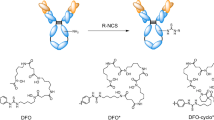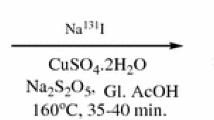Abstract
In order to select a chelator with excellent stability, easier radiolabeling process and low cost, GRPr antagonist RM26 with the amino acid based chelator was radiolabeled with technetium-99m. The stability of the radiolabeled peptides in PBS, serum as well as in the presence of excess cysteine was compared.









Similar content being viewed by others
References
Schroeder RPJ (2009) Peptide receptor imaging of prostate cancer with radiolabeled bombesin analogues. Methods 48:200–204
Mansi R (2013) Targeting GRPR in urological cancers-from basic research to clinical application. Nat Rev Urol 10:235–244
Carsten K (2013) Hybrid bombesin analogues: combining an agonist and an antagonist in defined distances for optimized tumor targeting. J Am Chem Soc 135:16793–16796
Mansi R (2011) Evaluation of a 1,4,7,10-tetraazacyclododecane-1,4,7,10-tetraacetic acid-conjugated bombesin-based radioantagonist for the labeling with single-photon emission computed tomography, positron emission tomography, and therapeutic radionuclides. Clin Cancer Res 15:5240–5249
Ginj M (2006) Radiolabeled somatostatin receptor antagonists are preferable to agonists for in vivo peptide receptor targeting of tumors. Proc Natl Acad Sci USA 103:16436–16441
Ginj M (2006) Radiolabeled somatostatin receptor antagonists are preferable to agonists for in vivo peptide receptor targeting of tumors. PNAS 103:16436–16441
Kristell LSC (2014) Preclinical comparison of Al18F and 68Ga labeled gastrin-releasing peptide receptor antagonists for PET imaging of prostate cancer. J Nucl Med 12:2050–2056
Mansi R (2016) Bombesin-targeted PET of prostate cancer. J Nucl Med 10:67S–72S
Shirmardi SP (2011) Synthesis and evaluation of a new bombesin analog labeled with 99mTc as a GRP receptor imaging agent. J Radioanal Nucl Chem 288:327–335
Monroy-Guzman F (2003) Effect of Zr: Mo ratio on 99mTc generator performance based on zirconium molybdate gels. Appl Radiat Isot 59:27–34
Monroy-Guzman F (2012) Production optimization of 99Mo/99mTc zirconium molybate gel generators at semi-automatic device: DISIGEG. Appl Radiat Isot 70:103–111
Abram U (2006) Technetium and rhenium—coordination chemistry and nuclear medical applications. J Braz Chem Soc 17:1486–1500
Lei K (1996) Technetium-99m antibodies labeled with MAG3 and SHNH: an in vitro and animal in vivo comparison. Nucl Med Biol 23:917–922
Zhang Y (2000) Influence of different chelators (HYNIC, MAG3 and DTPA) on tumor cell accumulation and mouse biodistribution of technetium-99m labeled to antisense DNA. Eur J Nucl Med 27:1700–1707
Vanderheyden JL (2006) Evaluation of 99mTc-MAG3-annexin V: influence of the chelate on in vitro and in vivo properties in mice. Nucl Med Biol 33:135–144
Hjelstuen OK (1998) 3′-99mTc labeling and biodistribution of a CAPL antisense oligodeoxynucleotide. Nucl Med Biol 25:651–657
Verduyckt T (2003) Identity confirmation of 99mTc-MAG3, 99mTc-Sestamibi and 99mTc-ECD using radio-LC-MS. J Pharmaceut Biomed. 32:669–678
Kan W (2016) Coordination investigation of rhenium with MAG3 using LC-MS and UV spectrometer and the simple radiolabelling process. J Radioanal Nucl Chem 310:695–702
Acknowledgements
This research is financially supported by Science and Technology Development of Foundation of China Academy of Engineering Physics (2014A0301011) and China National Natural Science Foundation (21571164).
Author information
Authors and Affiliations
Corresponding author
Rights and permissions
About this article
Cite this article
Zhong, Z., Kan, W. & Liao, W. Stability evaluation of Tc-99m radiolabeled GRPr antagonist with amino acid chelators. J Radioanal Nucl Chem 319, 453–458 (2019). https://doi.org/10.1007/s10967-018-6363-6
Received:
Published:
Issue Date:
DOI: https://doi.org/10.1007/s10967-018-6363-6




